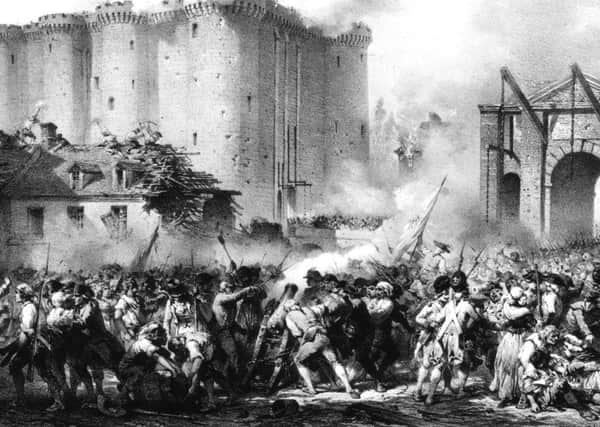Stuart Kelly: Just how French was the French Revolution?


Liberty Or Death: The French Revolution by Peter McPhee | Yale University Press, £25
Peter McPhee’s bold and scrupulously researched book poses a question I had not beforehand considered: just how French was the French Revolution? It is a question that has to be approached from numerous angles.
Advertisement
Hide AdAdvertisement
Hide AdIntellectually, its origins lay in the American Revolution, the philosophy of the Genevan Jean-Jacques Rousseau and, to a lesser extent, the British creation of a constitutional monarchy after the events of 1688. The Revolution itself was not limited to France. As with most revolutions, preserving internal integrity meant exporting the agenda: hence the annexation of Belgium and the creation of the Batavian, Helvetican and Cisalpine “sister republics”, both satellite states and buffer zones. France itself was also more than its European land-mass, and McPhee pays a significant deal of attention to the Caribbean aspects of the Revolution, although more might have been written about Toussaint Louverture’s Haitian revolt.
Nor was pre-Revolutionary France a homogenous nation state in the way it was after the Revolution. As McPhee observes early on, many of the inhabitants spoke Breton, Occitan, Provençal, Basque, or Flemish. He quotes the Abbé Albert complaining that he “was never able to make myself understood by the peasants… I spoke to them in French, I spoke to them in my native patois, I even tried to speak to them in Latin, but all to no avail.” Local regions had distinct systems of weights, measures and reckonings of distance. Educational reform and standardisation with the metric system brought a new kind of unity to France.
Then there is the difference between Paris and the rest of France. Was it a Parisian Revolution, foisted on the rest of the country? Perhaps even more telling than, say, the resistance in the Vendée is the fact that during the counter-revolutionary Terror, Marseille was renamed “Sans Nom”, “Without Name”.
What had united France? Technically, the monarchy, although the average French subject would have had little personal contact with the king. In one of the ironic asides which typify this volume, McPhee notes that “Louis XVII” died at the age of ten from scrofula, the so-called “King’s Evil” that his father would have “cured” peasants of by the laying on of regal hands. More influential was the Catholic Church. McPhee discusses the requisition of church bells for armaments, and evokes a suddenly silent French countryside. The statistics are astonishing. A quarter of all priests – as many of 40,000 – emigrated. Three thousand died violent deaths. Not only did the Church lose land, tithes and political influence, the programme of dechristianisation changed the names of towns, streets and even children. There is something grotesquely comic about a detail like Montmartre being renamed Mont-Marat, or an Alpine couple naming their daughter Phytogynéantrope (Greek for a woman who bears only warrior sons).
McPhee is particularly good on popular culture during the Revolution. The explosion of newspapers and songs further bound together the often disparate groups with competing grievances. In stark contrast to the British “Glorious Revolution”, the French Revolution depended on the creation of a shared iconography, from the Revolutionary Calendar to the imposing portrait of Marat in the Convention to the plantation of liberty trees and the Phrygian bonnets. Nevertheless, McPhee writes that “despite the richness of Revolutionary culture, it could not replace a Catholicism that seemed to many people deeper in substance and promise”.
It is almost de rigueur for histories of the Revolution to quote Zhou Enlai’s maxim about it being “too soon” to know its influence; and McPhee wisely forgoes it for Mao: “A revolution is not a dinner party, or writing an essay, or painting, or doing embroidery; it cannot be so refined, so leisurely and gentle, so temperate, kind, courteous, restrained and magnanimous.” That gets to the central point about what the French Revolution invented: the idea of the revolution. Who declares when a revolution is accomplished and its “history can now be written”? As Robespierre said, “would you have a revolution without a revolution?” From Burke to Goethe and Wordsworth to Beethoven there was a realisation that the revolution was a decisive, even cataclysmic, break with the past.
Unlike his topic, McPhee’s book is restrained and magnanimous. The precision of statistics and even-handedness may hold back the narrative impetus; but the complexity is welcome in comparison with the co-option of the Revolution by writers as different as Simon Schama and Slavoj Zizek. McPhee has a keen eye for the telling anecdote. My favourite was the production of Calderon’s Life Is A Dream in Bordeaux, where the audience became furious when the actor Auroch spoke the line, “Long live our noble king!” All 86 members of the company were arrested, and Auroch sent to the guillotine, all the while maintaining “But it was in my part!” Revolutions are where seeming, being and becoming are fatally intertwined.